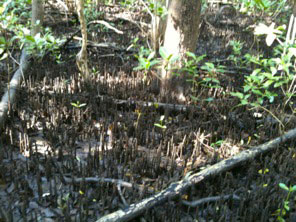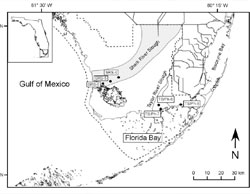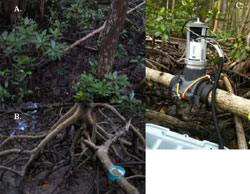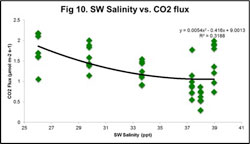Soil, water, and coarse woody debris carbon dioxide (CO2) fluxes and aqueous CO2 in a tidal mangrove forest in the Florida Everglades

High pneumatophore density is a key feature of the site in closest proximity to the coast due to the presence of black mangrove (Avicennia germinans) in the forest community.
Background
Mangrove forests cover 1% of the continental surface but represent large C stocks (eg. Micronesian forest 400-1400 Mg C ha-1; Kauffman et al. 2011) due to large belowground C stocks. Respiration flux from belowground, as CO2 to the atmosphere or as dissolved aqueous CO2, is a key component of coastal C cycling.
The soil compartment is comprised of CO2 fluxes from soil, roots and root structure (i.e. pneumatophores), coarse woody debris (CWD) to the atmosphere, and when inundated, to surface water (SW). Variation in soil respiration fluxes can be a function of numerous physical and biological factors including temperature, root production, benthic microalgae, invertebrates, duration and frequency of inundation, salinity, alkalinity and nutrient availability.
Research Objectives
Our goal is to quantify in soil CO2 flux rates and patterns of aqueous pCO2 as a function of inter- and intra-site variability to elucidate key factors controlling soil respiration fluxes and losses of mangrove forest C.
We are accomplishing this work by quantifying: 1) CO2 fluxes from soil (and as a function of pneumatophore density), coarse woody debris and surface water using a LICOR 8100 soil respiration system and various types of fabricated cuvettes, 2) aqueous pCO2 in surface water and soil water, 3) salinity, 4) water level, 5) temperature, 6) DOC concentration, and 7) pH.
Study Area
The Shark River Slough estuary is located on the extreme SW coastal margin of the Florida Everglades. The extensive riverine mangrove forests are dominated by red (Rhizophora mangle), black (Avicennia germinans) and white (Laguncularia racemosa) mangroves. The climate of South Florida is subtropical moist with distinctive wet and dry seasons. Peat soils exceeding 1m in depth are supported by a limestone platform. The hydrology of the forests is driven by seasonal freshwater inputs and tidal advection.
Our study sites coincide with Florida Coastal Everglades LTER sites SRS-4, SRS-5 and SRS-6 along a transect from the more freshwater influenced SRS-4, to the more saline end-member, SRS-6 (for more information about study sites, go to www.fce.lternet.edu. The three sites vary most notably in vegetation structure, frequency of inundation, salinity, soil C:N, soil P and soil organic matter content (Castaneda 2010).
 The FCE LTER mangrove study sites in Shark River Slough (SRS-4, SRS-5 and SRS-6) and southeastern Everglades (TSPh-6 and TSPh-7). The SRS-6 site is also part of the Ameriflux Network.
The FCE LTER mangrove study sites in Shark River Slough (SRS-4, SRS-5 and SRS-6) and southeastern Everglades (TSPh-6 and TSPh-7). The SRS-6 site is also part of the Ameriflux Network.
 CO2 flux measurements of course woody debris and soil with the presence of pneumatophores have shown the highest instantaneous fluxes.
CO2 flux measurements of course woody debris and soil with the presence of pneumatophores have shown the highest instantaneous fluxes.
 Surface water salinity is one key factor contributing to soil CO2 flux.
Surface water salinity is one key factor contributing to soil CO2 flux.
Project Collaborators
Jose Fuentes, Jordan Barr, Victor Engel, Gordon Anderson, David Lagomasino, René Price, Stephen Davis
Funding sources
National Park Service
National Science Foundation
Department of Energy National Institute for Climate Change Research Program
Interested in contributing to this work? Contact us at troxlert@fiu.edu or sanchezo@fiu.edu.

